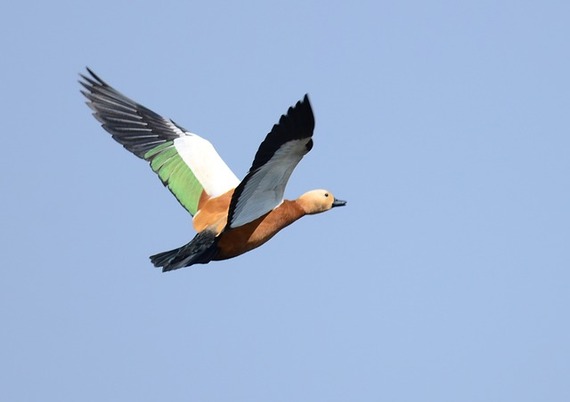Fantasies of Flying
An intimate relationship binds birds and humans. Humans may have fascination for all animals and may make pets out of dogs, cats, fish, and in some cases even bigger animals, such as llamas, goats and cubs. But birds are more than incarcerated pets. (In fact, caging birds and clipping their wings are transgressions against nature.) Birds mesmerize humans with their melodies, colors, feathers and most prominently, flying. Of all created life forms (except angels), only birds aviate with sustained beauty. Most life forms are detainees of the earth's surface, but birds are free, living and breathing above the ground. Caliology, the study of bird nests, reveal how most birds make their nests in trees and high places in the outdoors. Humans may offer artificial bird nests that some birds politely decline. Love birds teach humans the bravery of delicate intimacy expressed in public. They are not reluctant to show sadness or sing solos of loneliness. To some degree, all humans are bird watchers.
Birds as feathered beings are vested with the ability to fly. Feathers are the most salient part of flying beings. Mere feathers, however, are insufficient to fly. In addition to feathers, birds have light bodies. An elephant equipped with feathers will be unable to fly because of its huge mass. (Note, however, scientists believe that birds were dinosaurs once upon a time.) Most birds have hollow bones that weigh much less than regular bones. They also have light beaks rather than heavy teeth. The light body of feathered beings is maintained with high metabolism. Food provides energy. However, indigestible foods are unsuitable for feathered beings. Most birds eat seeds, fruits, and easily digestible meat to procure energy. Humans only wish to eat like birds.
Birds as feathered beings are vested with the ability to fly. Feathers are the most salient part of flying beings. Mere feathers, however, are insufficient to fly. In addition to feathers, birds have light bodies. An elephant equipped with feathers will be unable to fly because of its huge mass. (Note, however, scientists believe that birds were dinosaurs once upon a time.) Most birds have hollow bones that weigh much less than regular bones. They also have light beaks rather than heavy teeth. The light body of feathered beings is maintained with high metabolism. Food provides energy. However, indigestible foods are unsuitable for feathered beings. Most birds eat seeds, fruits, and easily digestible meat to procure energy. Humans only wish to eat like birds.
The physiology of feathered beings is constructed for flying. For example, feathered beings do not have bladders to store urine because a full bladder adds weight to the body. Birds do not conceive babies since pregnant bodies will be harder to fly. Instead, they lay eggs for propagation. Yet, like almost always, nature burdens female birds with the chores of reproduction. Even holding a fertilized egg inside the body restricts the liberty of female birds to freely fly, though for a short while. Additionally, most female birds spend time in nests, infrequently in the company of sex partners, for incubating eggs and raising hatchlings that need care and feeding.
First imitating and now surpassing the aerodynamics of birds, humans have invented airplanes that can fly at high speeds, including supersonic aircrafts. Every day, there are over 200,000 flights around the world. Most airplanes have wings, engines, and pilots. There are exceptions. Drones may fly without pilots. Hot air balloons may sail without wings. New planes, like D-Dalus, are being researched, which may not use wings or rotors to take off, fly, and land. Nonetheless, human aviation shadows the tradition of birds as most planes have some sort of tails and wings with varying paint colors. Jet-powered wing suits are available for solo flights. Some planes are powered by solar energy but most use gasoline as fuel for flying. Human aviation has overcome the weight problem and planes can be designed for carrying massive loads of military hardware. The Antonov An-124 Ruslan, for example, is a large Russian aircraft that can fly carrying a load of 150 tons. Nonetheless, the adventures of making paper planes continue to thrill children.
For centuries, flying has been a popular metaphor in fantasy and fiction. The magic carpet in One Thousand and One Nights tells the story of a prince buying a carpet in India, which would take the prince, in the twinkling of an eye, to far-flung places otherwise hard to reach. In modern games, such as The Legend of Zelda, a merchant rides the magic carpet passing through the Creepy Wasteland. The question intrigues children and physicists whether Batman can safely land after flying with his cape. Does Superman have negative mass when he flies in space? Video games are most enthralling when characters and weapons take to flying. Flying introduces the z-axis into human awareness, liberating minds from the confines of x-axis and y-axis, the predominant two-dimensional reality of earthly life.
Flying in dreams is no fiction. It is real and may reveal the dreamer's secret fears and desires. Flying freely in dreams is a joy, a wishful pleasure released from mundane burdens. Flying without control is scary: it may mean the dreamer's fear of lack of control, or just fatalistic resignation to whatever is happening in life.
Flying in dreams is no fiction. It is real and may reveal the dreamer's secret fears and desires. Flying freely in dreams is a joy, a wishful pleasure released from mundane burdens. Flying without control is scary: it may mean the dreamer's fear of lack of control, or just fatalistic resignation to whatever is happening in life.
Interpretations of flying in dreams are as fantastical as interpretations of statutes in law. For example, not able to fly, though arms are stretched out, may signal powerlessness or indecision or fear of flying. Flying together with someone else may portend romance or career advancement. Flying backwards may signify nostalgia, opposition, or dogmatism. Flying in circles may mean boredom, devotion, or circumferential anxiety. Flying to heavens may mean spiritual awakening or a brooding desire to reach an alien space craft. Flying over an ocean may mean a desire to meet someone in Amsterdam, or it may mean confession of self-superficiality. Flying away from your spouse needs no interpretation. If you dream feathers growing all over your body, wake up and answer the phone call from the Norwegian Nobel Committee.
Follow Liaquat Ali Khan on Twitter: www.twitter.com/abukashif




Comments
Post a Comment